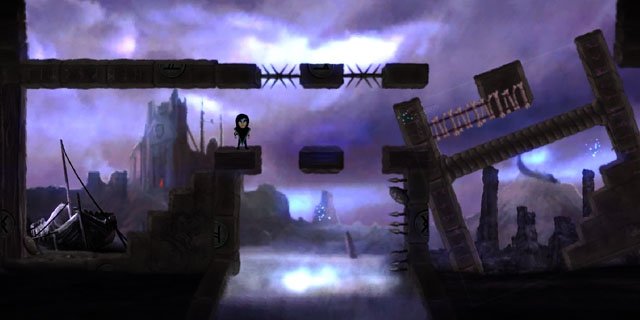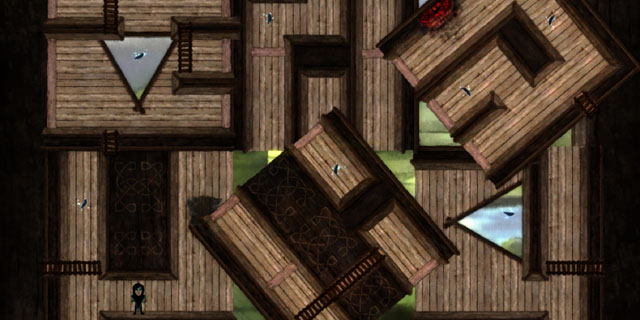
I’m torn.
On one hand, Munin is a well-assembled puzzle game. On the other, it’s almost completely devoid of plot and wastes the Norse setting completely. You play as the titular Munin, one of Odin’s two messenger ravens. The other raven, Hunin, is mentioned once in a screen of text and then never seen again. Loki has transformed Munin into a mortal man, and Munin must scour the world for his feathers. After collecting all of them, Munin can return to Odin who will, presumably, slap Loki on the hand and make him promise to be a good boy from now on.
Munin is easy to control. You use the arrow keys to move, hit the space bar to jump and click to rotate bits of the world to solve puzzles. In the first world (of which there are nine), core mechanics are introduced. Feathers are scattered about the screen, and Munin needs to collect them. After collecting them, he is able to move on to the next level.
The feathers aren’t easy to grab, even in level one, because Munin isn’t a platformer. You’ll need to rotate sections of the world to allow Munin to access otherwise-locked portions of the level. Sometimes rotating one tile causes another to rotate at the same time, but I had a very difficult time seeing the additional tiles highlighted and was always surprised when multiple tiles rotated simultaneously. All it really means is that when you want to rotate one tile and can’t, there’s a chance that you’re standing in a linked tile. And since you can’t rotate what you’re standing in, nothing moves at all.

Opening up new pathways, collecting feathers and finding your way back to safety to do it all again makes for a good set of brain-scratching puzzles. The Norse setting is just that, though: an arbitrary setting. Munin, under a different name, could just as easily be a game about a robot looking for bits and bolts to reassemble its companion, or a wizard’s assistant collecting magical ingredients to heal the shattered world. If you’re going to commit to a setting and visual motif, you need a good story to go along with it. Munin relies on text screens in a hard-to-read typeface, and it really makes it feel like the mechanics and puzzles were created before the Norse theme was draped atop it.
Munin, on top of feeling divorced from its theme, gets ridiculously difficult. Being difficult isn’t a terrible sin on its own, of course. Going back for 100% completion in difficult games can be very rewarding. I struggled against Jaguar Javier in Guacamelee! for hours, because I loved the game and really wanted to get all of its achievements. In order to get there, though, I needed to complete the game on normal difficulty and then decide to go back and try for more.
In Munin, the level presented is the level you must complete to move on. There is no level skip, there are no hints and, in order to complete the level, you must collect all of the feathers. I really feel like allowing the player to move on after obtaining 50% collection would make the game a better experience. Following that, players can go back via level select if they want to grab additional feathers and see the best ending where Munin and Loki re-enact scenes from The Birds (not actually the ending of the game). Instead, most players will never see the ending, because they’ll get tired of being stuck on a level with seemingly no way to progress.

There’s a good game in there, but the Munin that I want to play is hiding behind forced 100% completion and a lack of devotion to the Norse motif. If nefariously hard puzzles and an interesting mechanic are what you’re after, though, then Munin will serve you and your MENSA-level IQ just fine.
Pros: Interesting world-rotating mechanic, lots of levels
Cons: Hard to tell what tiles are connected, no hints and forced completion



















